Kruger National Park lies in the north east of South Africa and is about the size of Israel or Holland. The President of the country in 1898, Mr. Paul Kruger thought it important to set aside a tract of land to be preserved as a National Game reserve but it took many years before it was finally proclaimed in 1926. The first camp was Pretoriuskop and all it had was a small circular road going around it. Later, land adjoining the Sabi Park as it was called then, belonging to Mr. and Mrs. Orpen was donated to the park and so it continued to grow to its present size.
The Park sits on the Tropic of Capricorn and this means that it is warm to hot the whole year round, needing only a light jacket or sweater on winter nights.
It is about 4-5 hours travel from Johannesburg and my home so I do not get there too often, but I took a Thursday and Friday off recently to make it a long weekend and went up there to spend some time relaxing.
Going over the first bridge, this Giant Kingfisher was sitting on the bank looking for lunch in the water below. He is the largest of several kingfishers we have here and is about the same size as a dove.
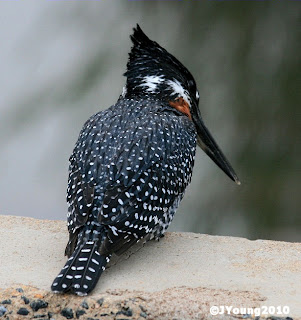 His cousin, the Pied Kingfisher was on the otherside doing the same thing. The streams running through the park host several species of fish which are eaten by many different bird species.
His cousin, the Pied Kingfisher was on the otherside doing the same thing. The streams running through the park host several species of fish which are eaten by many different bird species. Our first animal sighting was of course the Impala, with an estimated 128,000 in the park, there is no corner you can go around without seeing them. They are of medium size and at this time of the year, the females are on heat for 6 weeks, so the poor males spend most of their time guarding that other males do not steal them.
Our first animal sighting was of course the Impala, with an estimated 128,000 in the park, there is no corner you can go around without seeing them. They are of medium size and at this time of the year, the females are on heat for 6 weeks, so the poor males spend most of their time guarding that other males do not steal them.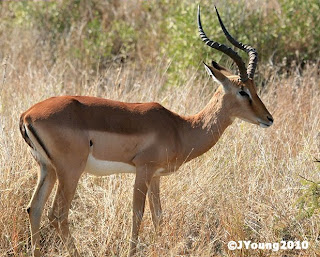 It is extremely dry there now with no rain having fallen for many months. Because of this, the animals are to be found around the streams and watering holes, and with no leaves on most of the trees, game is very easily seen. During the four days we were there, we saw a lot of Elephant as they are one species which depend on water and are never found far away. This large bull crossed the road in front of us and went merrily on his way.
It is extremely dry there now with no rain having fallen for many months. Because of this, the animals are to be found around the streams and watering holes, and with no leaves on most of the trees, game is very easily seen. During the four days we were there, we saw a lot of Elephant as they are one species which depend on water and are never found far away. This large bull crossed the road in front of us and went merrily on his way. A female Kudu was browsing on dry leaves at the side of the road. During the winter season they eat whatever is still on the bushes although there are some which have leaves the whole year through. If you watch Kudu eat, you will see that they brows for a long while on a bush and then suddenly will jerk their heads away. This is an indication that the bush has put out a lot off tannin to protect itself and make it inedible. A survival tactic.
A female Kudu was browsing on dry leaves at the side of the road. During the winter season they eat whatever is still on the bushes although there are some which have leaves the whole year through. If you watch Kudu eat, you will see that they brows for a long while on a bush and then suddenly will jerk their heads away. This is an indication that the bush has put out a lot off tannin to protect itself and make it inedible. A survival tactic.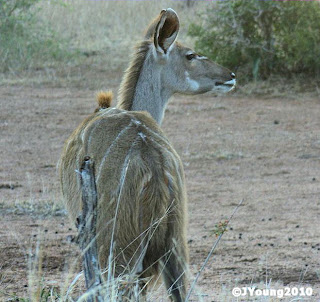 At certain times of the year, the Zebra and Blue Wildebeest migrate around the park as the first summer rain always comes to the southern part of the park first.
At certain times of the year, the Zebra and Blue Wildebeest migrate around the park as the first summer rain always comes to the southern part of the park first.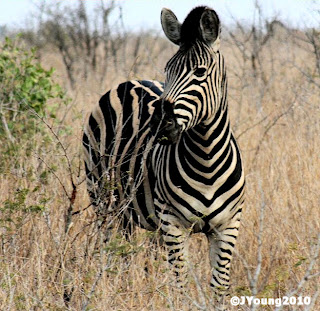 They are found in great numbers and will often stand in the middle of the road, soaking up the early sunshine.
They are found in great numbers and will often stand in the middle of the road, soaking up the early sunshine.
These two White Rhino were also enjoying the sun and not planning to move until mealtime.
 A lot of our birds migrate for the winter and are now starting to come back as it warms up towards summer. This is a Black-eyed Bulbul and is one which is found here the whole year through.
A lot of our birds migrate for the winter and are now starting to come back as it warms up towards summer. This is a Black-eyed Bulbul and is one which is found here the whole year through.
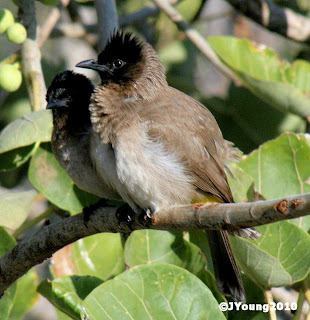 A male Kudu has very long spiral horns which he uses to bring down branch otherwise to high to browse on. But if all else fails, will enjoy the tiny bit of green grass he finds at the roads edge. These are very large buck and stand about 5 feet at shoulder height.
A male Kudu has very long spiral horns which he uses to bring down branch otherwise to high to browse on. But if all else fails, will enjoy the tiny bit of green grass he finds at the roads edge. These are very large buck and stand about 5 feet at shoulder height.
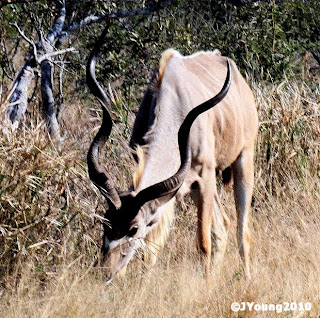 A Lilac-breasted Roller sits trying to find a meal, but insects are scarce now.
A Lilac-breasted Roller sits trying to find a meal, but insects are scarce now.
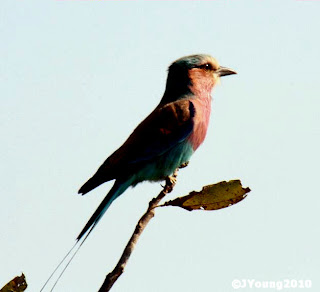 What would a trip be without at least one bug and this unusual moth flew into a tree above my head. He unfortunately flew off to fast for me to get a proper look at him for identification purposes.
What would a trip be without at least one bug and this unusual moth flew into a tree above my head. He unfortunately flew off to fast for me to get a proper look at him for identification purposes.
 Another huge Elephant which was part of four males grazing away. They eat both grass and leaves and so are never short of food and add bark to their diets too as a change.
Another huge Elephant which was part of four males grazing away. They eat both grass and leaves and so are never short of food and add bark to their diets too as a change.
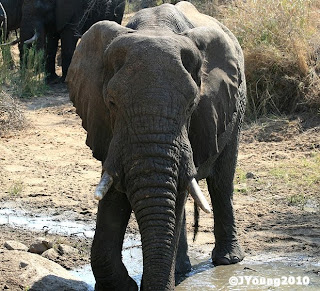 What a lovely way to end off our first day there, a Honey Badger!! It is not often we see them but once again, scarcity of food drives them out into the open.
What a lovely way to end off our first day there, a Honey Badger!! It is not often we see them but once again, scarcity of food drives them out into the open.
 They are vicious little creatures and will attack anything which gets in their way. Sorry they are not the best of pictures, but there was no time to set anything on the camera and I had to take what pics I could get.
They are vicious little creatures and will attack anything which gets in their way. Sorry they are not the best of pictures, but there was no time to set anything on the camera and I had to take what pics I could get.
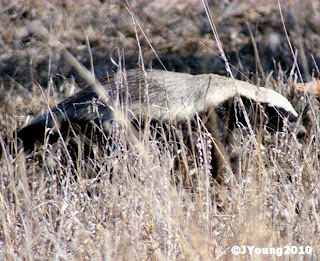 And so the moon comes out on our first day. It has been a lot of driving having come up all the way from home, but now we can look forward to shorter distances and we sit outside having a barbeque and listening to the sounds of the night coming alive with owls, crickets and other nocturnal game while sipping on a sherry.
And so the moon comes out on our first day. It has been a lot of driving having come up all the way from home, but now we can look forward to shorter distances and we sit outside having a barbeque and listening to the sounds of the night coming alive with owls, crickets and other nocturnal game while sipping on a sherry.
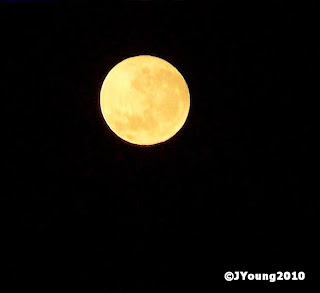
 A lot of our birds migrate for the winter and are now starting to come back as it warms up towards summer. This is a Black-eyed Bulbul and is one which is found here the whole year through.
A lot of our birds migrate for the winter and are now starting to come back as it warms up towards summer. This is a Black-eyed Bulbul and is one which is found here the whole year through. A male Kudu has very long spiral horns which he uses to bring down branch otherwise to high to browse on. But if all else fails, will enjoy the tiny bit of green grass he finds at the roads edge. These are very large buck and stand about 5 feet at shoulder height.
A male Kudu has very long spiral horns which he uses to bring down branch otherwise to high to browse on. But if all else fails, will enjoy the tiny bit of green grass he finds at the roads edge. These are very large buck and stand about 5 feet at shoulder height. A Lilac-breasted Roller sits trying to find a meal, but insects are scarce now.
A Lilac-breasted Roller sits trying to find a meal, but insects are scarce now. What would a trip be without at least one bug and this unusual moth flew into a tree above my head. He unfortunately flew off to fast for me to get a proper look at him for identification purposes.
What would a trip be without at least one bug and this unusual moth flew into a tree above my head. He unfortunately flew off to fast for me to get a proper look at him for identification purposes. Another huge Elephant which was part of four males grazing away. They eat both grass and leaves and so are never short of food and add bark to their diets too as a change.
Another huge Elephant which was part of four males grazing away. They eat both grass and leaves and so are never short of food and add bark to their diets too as a change. What a lovely way to end off our first day there, a Honey Badger!! It is not often we see them but once again, scarcity of food drives them out into the open.
What a lovely way to end off our first day there, a Honey Badger!! It is not often we see them but once again, scarcity of food drives them out into the open. They are vicious little creatures and will attack anything which gets in their way. Sorry they are not the best of pictures, but there was no time to set anything on the camera and I had to take what pics I could get.
They are vicious little creatures and will attack anything which gets in their way. Sorry they are not the best of pictures, but there was no time to set anything on the camera and I had to take what pics I could get. And so the moon comes out on our first day. It has been a lot of driving having come up all the way from home, but now we can look forward to shorter distances and we sit outside having a barbeque and listening to the sounds of the night coming alive with owls, crickets and other nocturnal game while sipping on a sherry.
And so the moon comes out on our first day. It has been a lot of driving having come up all the way from home, but now we can look forward to shorter distances and we sit outside having a barbeque and listening to the sounds of the night coming alive with owls, crickets and other nocturnal game while sipping on a sherry.

2 comments:
Brings back fond memories.
Another WONDERFUL trip. Love it Joan! Along with the awesome pictures, I learn lots!
Post a Comment